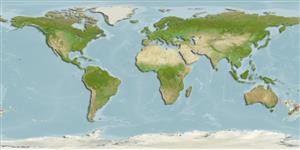分類 / Names
俗名 | 同種異名 | Catalog of Fishes(屬, 種) | ITIS | CoL | WoRMS | Cloffa
Holocephali
全頭亞綱 (銀鮫科) (chimaeras) >
Chimaeriformes (Chimaeras)
銀鮫目 (Chimaeras) >
Chimaeridae (Shortnose chimaeras or ratfishes)
短鼻銀鮫科 (Shortnose chimaeras or ratfishes)
Etymology: Chimaera: Named for the mythological creature composed of parts of multiple animals, referring to their odd mix of characteristics. (See ETYFish); obscura: Latin for dark, referring to dark brownish-to-black body coloration. (See ETYFish).
More on authors: Didier, Last & White.
Environment: milieu / climate zone / depth range / distribution range
生態學
海洋 深海底的; 深度上下限 450 - 1080 m (Ref. 76965).
Southwest Pacific: Australia.
大小 / 重量 / 年齡
Maturity: Lm ? range ? - ? cm
Max length : 95.1 cm TL (female)
簡短描述
檢索表 | 型態特徵 | 形態測量圖
This species is distinguished from its congeners by the following set of characters: skin thin and deciduous; color uniformly dark brownish to black; preopercular and oral lateral line canals either sharing a common branch or not; long dorsal spine, longer than first dorsal fin; structure of the CO1 gene (Ref. 76965).
Life cycle and mating behavior
Maturities | 繁殖 | Spawnings | Egg(s) | Fecundities | 仔魚
Didier, D.A., P.R. Last and W.T. White, 2008. Three new species of the genus Chimaera Linnaeus (Chimaeriformes: Chimaeridae) from Australia. In Last, P.R., White, W.T. & Pogonoski, J.J. (eds.): Descriptions of New Australian Chondrichthyans. CSIRO Marine and Atmospheric Research Paper no. 22. (Ref. 76965)
IUCN 瀕危狀態 (Ref. 130435)
無危 (LC) ; Date assessed: 28 November 2019
人類使用
工具
特別的報告
下載 XML
網路資源
Estimates based on models
Preferred temperature (Ref.
123201): 5.2 - 9, mean 6.9 °C (based on 64 cells).
Phylogenetic diversity index (Ref.
82804): PD
50 = 0.5000 [Uniqueness, from 0.5 = low to 2.0 = high].
Bayesian length-weight: a=0.00282 (0.00118 - 0.00673), b=3.10 (2.89 - 3.31), in cm total length, based on LWR estimates for this (Sub)family-body shape (Ref.
93245).
營養階層 (Ref.
69278): 3.7 ±0.6 se; based on size and trophs of closest relatives
回復力 (Ref.
120179): 低的, 最小族群倍增時間4.5 - 14 年 (Deepwater species with few large eggs.).
Fishing Vulnerability (Ref.
59153): High vulnerability (58 of 100).
